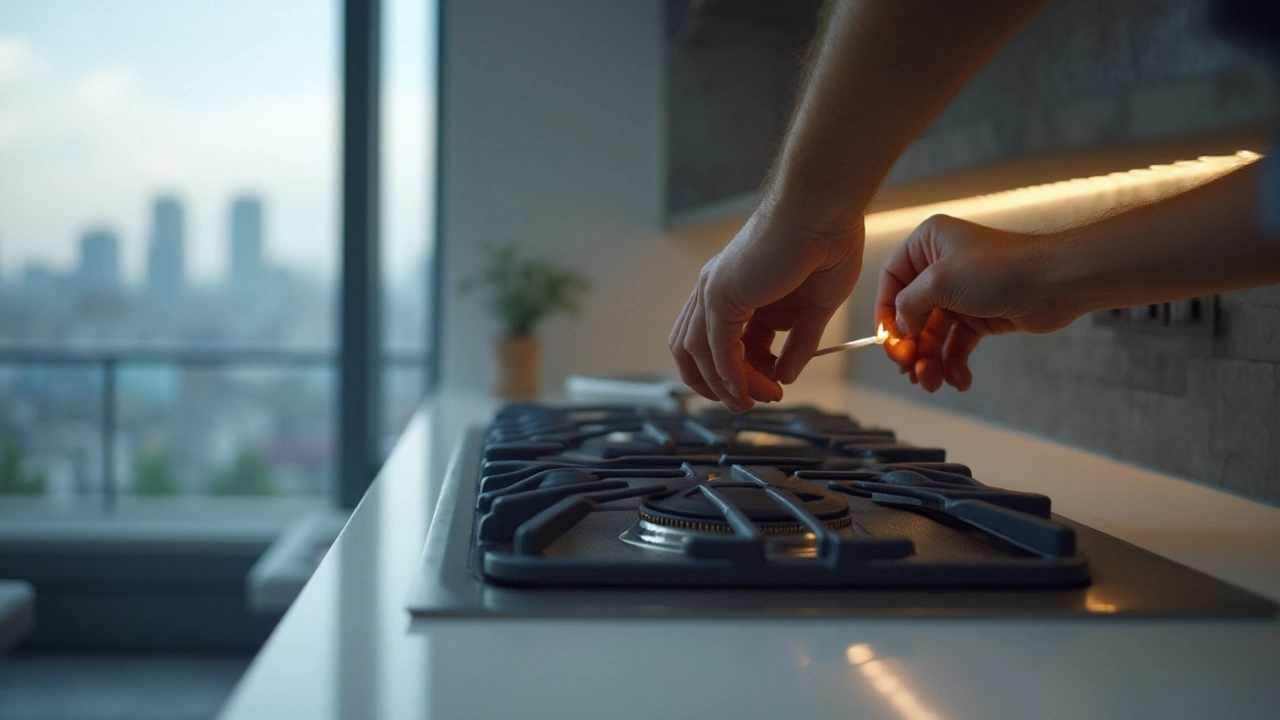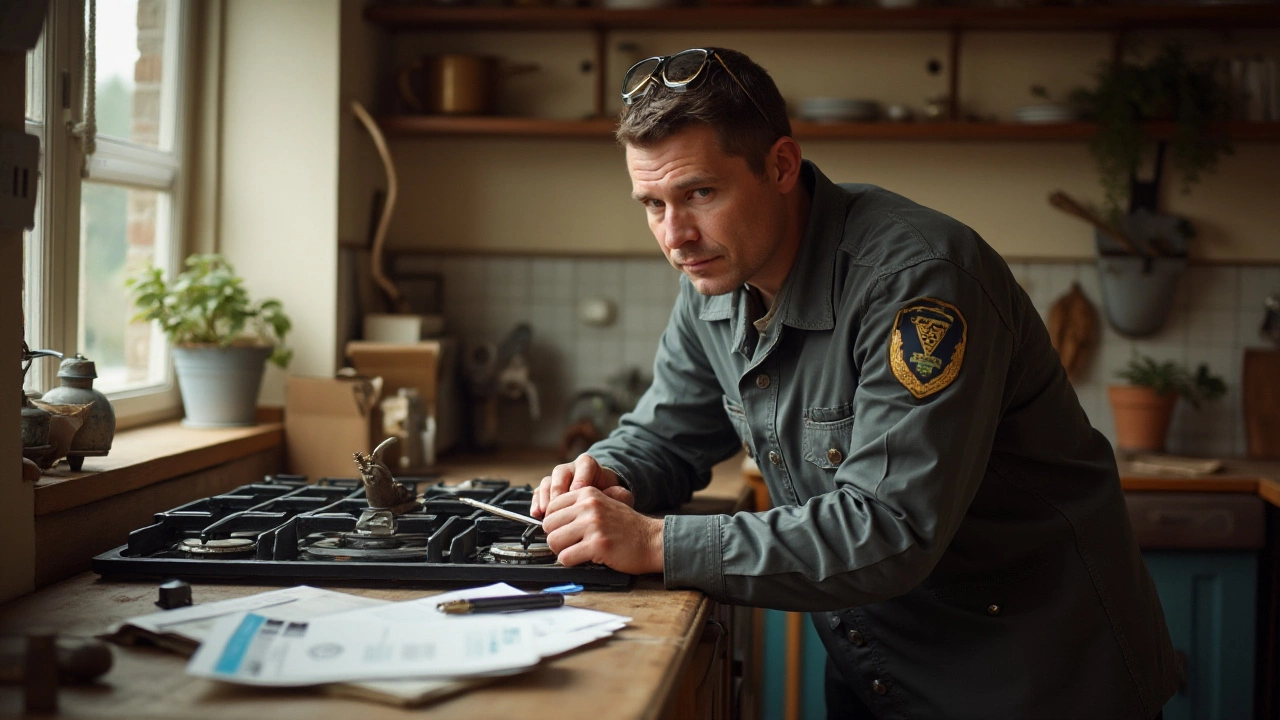Common Reasons Gas Hobs Fail and How to Fix Them
 Oct, 31 2024
Oct, 31 2024
Gas hobs are the heart of many kitchens, offering efficient and precise cooking capabilities. Yet, as with any hardworking appliance, they can sometimes hit a snag. One day you're preparing a quick dinner, the next, your hob refuses to light or exhibits an odd, flickering flame.
This kind of hiccup can be frustrating, especially when you're in the middle of preparing a meal. Understanding why these issues occur is half the battle. Whether it's the ignition switch not sparking or an uneven flame dancing under your pots, knowing what to look for can help you in resolving these issues effectively.
In this article, we'll venture into the world of gas hob troubles, shedding light on why they stop working and how you can tackle these problems without the need for a professional. After all, a little DIY intervention can save time and costs while keeping your kitchen operations smooth and efficient.
- Understanding Your Gas Hob
- Common Problems with Gas Hobs
- Troubleshooting Tips
- Maintenance and Safety Tips
Understanding Your Gas Hob
Gas hobs have long been a favorite in kitchens around the world, praised for their quick response and control over heat levels. Understanding how your gas hob functions can provide insights into why it might not always work as expected. A gas hob primarily relies on a few key components: the burners, ignition system, gas supply, and control knobs. Each plays a vital role in ensuring the hob lights up and maintains a steady flame.
The burners on a gas hob are where the magic happens. They are designed to distribute gas evenly, which is then ignited by a spark to produce a flame. The size and configuration of burners can vary, but all are intended to deliver consistent heat. Despite their durability, burners can become clogged or damaged over time, affecting their performance. Regular cleaning and maintenance can prevent such issues from occurring.
The ignition system is often where problems arise. There are typically two types: manual and automatic. Automatic ignitions use an electric spark to light the gas, activated by turning the control knob. If the ignition system is faulty, you might hear a clicking sound without any flame appearing. This could be due to a worn-out spark generator or a misaligned igniter. Addressing these components can usually restore function and prevent gas hob repair emergencies.
Gas supply is the lifeline of any gas hob, providing the necessary fuel for the burners. It's crucial to ensure that the gas line is correctly connected and free from leaks. In some cases, the issue may not be with the hob itself but rather a disruption in the gas supply line. Regular checks and prompt attention to gas odors can ensure safety and efficiency in your kitchen. As Henry Petro wrote in his reference book on home appliances,
"A well-maintained gas supply ensures your kitchen runs smoothly, cooking becomes a joy, not a chore."
Lastly, the control knobs serve as your interface with the gas hob, allowing you to adjust flame intensity. If these knobs become loose or stuck, it may not be possible to control the burners effectively. This can often be resolved with a simple cleaning or replacement, restoring full control over your cooking experience. Understanding these components and their interactions can provide the knowledge needed to troubleshoot and maintain your gas hob effectively, avoiding common pitfalls often encountered by users.

Common Problems with Gas Hobs
When it comes to using a gas hob, reliability reigns supreme. But occasionally, things go awry and having some understanding of the potential issues can go a long way in preventing frustration. One prevalent problem occurs when the hob fails to ignite. This is often due to a dirty or clogged burner head. Residues from food often end up caking the burners, blocking gas flow. It's equally common for the spark ignition system to falter when it's damp or simply worn down from frequent use. Addressing these issues can often restore the function of the hob without needing a service call.
"Regular maintenance and cleaning can significantly extend the life of your gas hob and assure safety," suggests Jeanette Blum, a home appliance expert.
Another frequent issue involves the gas hob producing uneven flames, which can be quite problematic for cooking. Uneven flames are usually tied to misaligned burners or blocked jets. These components need to channel gas efficiently for a uniform flame. It could also be an indicator of gas pressure issues. Low gas pressure often results in a weak flame or an uneven one, impacting cooking efficiency. Moreover, if you notice a yellow or orange flame instead of a blue one, it indicates incomplete combustion, which could signify a hazardous issue needing immediate attention to prevent carbon monoxide build-up.
Finally, one can't overlook the erratic clicking sound often heard when the hob fails to ignite but keeps attempting. This noise, typically rhythmic, can signal ignition attempts while gas flows but not enough heat is produced for ignition. This problem can sometimes arise when the appliance is facing ambient humidity issues. In some cases, the ignition module or the ignition switch itself becomes faulty, necessitating replacements. By understanding these gas hob problems, you can not only troubleshoot effectively but also maintain your appliance in top condition.

Troubleshooting Tips
When your gas hob suddenly stops working, it can be a nuisance and disrupt the flow of your kitchen. Understanding and spotting the right issue is essential if you want to troubleshoot effectively. First, take a deep breath and let's explore these symptoms one by one. The initial step is to identify if the ignition system is at fault. Often, users discover that their hob won't light, which can be due to a faulty igniter or a clogged burner. Check if you hear a clicking sound when you turn the knob; if absent, the igniter might need a replacement, or it could be a loose connection.
Another frequent issue is uneven flames, often resulting from dirt or food particles clogging the burner slots. Cleaning these slots using a thin wire can resolve the problem. It's critical to exercise caution and ensure that the stove is off before you begin this process. In some cases, the flames might appear too small or large. Adjusting the air shutter can help balance the gas-air mixture involved, optimizing the flame for effective cooking. It's noteworthy that different hobs can have varied designs, so consult the manual specific to your model.
Sometimes, it's the gas supply that's the culprit. If the ignition works, but there's no flame, check if the gas valve supplying your hob is open. It's also useful to inspect your gas line for kinks or damage. Always prioritize safety; a gas leak requires immediate professional attention. Hob maintenance is crucial to keep these issues at bay. Regular cleaning prevents buildup that could lead to blockages and uneven performance. Test the regulator if you suspect a supply issue; a faulty regulator might need replacing.
"Maintenance is the best preventative measure for keeping home appliances in prime condition, reducing the potential for costly repairs," says Joanna Williams, a home appliance expert.
If after all these checks, your gas stove problems persist, it could be an internal wiring issue, or perhaps the thermocouple (a safety device that detects if the pilot light is lit) is malfunctioning. Replacing these entails a much safer bet when done by a professional. It’s tempting to solve every problem with a DIY solution, but sometimes it’s best to consult an expert. You'll save time and ensure your safety isn't compromised.

Maintenance and Safety Tips
When it comes to ensuring the longevity and safe operation of your gas hob, routine maintenance is your best friend. Neglecting regular check-ups might lead to inconvenience at best and serious safety issues at worst. To avoid such pitfalls, it's important to set a schedule to clean and inspect your hob periodically. Start by making it a habit to wipe down the hob surface after every use. This simple practice not only keeps it shiny and new-looking but also prevents food buildup, which can clog the burners over time.
Twice a year, take some extra time to clean the hob more thoroughly. Remove the burner heads, and soak them in warm, soapy water to free any stubborn grime or greasy residue. It's crucial to let them dry completely before placing them back to avoid any mishaps. Inspect the ignition system as well, ensuring that the spark is clean and unobstructed. If you find the ignition faulty, it may be worth replacing, or, if you're unsure, seeking professional help.
"Regular maintenance is not just about longevity, it's about safety. Keeping your gas appliances in good working order is essential," says Michael Graham, a renowned home appliance expert.Safety is not just about maintenance; it's about being aware of the environment too. Always make sure your kitchen is well-ventilated when using gas appliances. If you smell gas and suspect a leak, it's critical to turn off the gas valve immediately and ventilate the area. Never use an open flame to check for leaks—this is a recipe for disaster!
Teaching yourself and family members how to safely operate the gas hob is just as important as maintenance. Everyone in the household should know where the gas shutoff is located and how to use it. Additionally, avoid storing flammable items like cloths, paper, or cooking oils near the hob as these can easily catch fire. A grease fire is particularly tricky, and knowing how to tackle one safely can save lives and property; using a fire blanket or a fitting lid to smother the flames is usually effective without escalating the situation.
Consider the quality of the gas you are using as well. It might not be the first thing that comes to mind, but using poor-quality gas can lead to inefficient burning and potentially damage the hob over time. Check with your supplier for information about the gas used in your area. And, not to forget, having an annual professional inspection can identify issues that might go unnoticed to the untrained eye, ensuring your hob's safety and efficiency.
